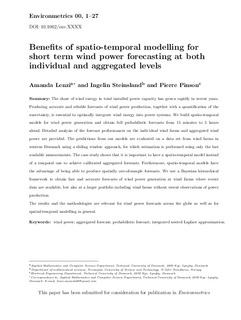| dc.contributor.author | Lenzi, Amanda | |
| dc.contributor.author | Steinsland, Ingelin | |
| dc.contributor.author | Pinson, Pierre | |
| dc.date.accessioned | 2019-05-13T10:54:55Z | |
| dc.date.available | 2019-05-13T10:54:55Z | |
| dc.date.created | 2018-09-28T10:06:58Z | |
| dc.date.issued | 2018 | |
| dc.identifier.citation | Environmetrics. 2018, 29 (3), 1-17. | nb_NO |
| dc.identifier.issn | 1180-4009 | |
| dc.identifier.uri | http://hdl.handle.net/11250/2597405 | |
| dc.description.abstract | The share of wind energy in total installed power capacity has grown rapidly in recent years. Producing accurate and reliable forecasts of wind power production, together with a quantification of the uncertainty, is essential to optimally integrate wind energy into power systems. We build spatiotemporal models for wind power generation and obtain full probabilistic forecasts from 15 min to 5 h ahead. Detailed analyses of forecast performances on individual wind farms and aggregated wind power are provided. The predictions from our models are evaluated on a data set from wind farms in western Denmark using a sliding window approach, for which estimation is performed using only the last available measurements. The case study shows that it is important to have a spatiotemporal model instead of a temporal one to achieve calibrated aggregated forecasts. Furthermore, spatiotemporal models have the advantage of being able to produce spatially out‐of‐sample forecasts. We use a Bayesian hierarchical framework to obtain fast and accurate forecasts of wind power generation not only at wind farms where recent data are available but also at a larger portfolio including wind farms without recent observations of power production. The results and the methodologies are relevant for wind power forecasts across the globe and for spatiotemporal modeling in general. | nb_NO |
| dc.language.iso | eng | nb_NO |
| dc.publisher | Wiley | nb_NO |
| dc.title | Benefits of spatiotemporal modeling for short-term wind power forecasting at both individual and aggregated levels | nb_NO |
| dc.type | Journal article | nb_NO |
| dc.type | Peer reviewed | nb_NO |
| dc.description.version | acceptedVersion | nb_NO |
| dc.source.pagenumber | 1-17 | nb_NO |
| dc.source.volume | 29 | nb_NO |
| dc.source.journal | Environmetrics | nb_NO |
| dc.source.issue | 3 | nb_NO |
| dc.identifier.doi | 10.1002/env.2493 | |
| dc.identifier.cristin | 1615478 | |
| dc.relation.project | Norges forskningsråd: 250362 | nb_NO |
| cristin.unitcode | 194,63,15,0 | |
| cristin.unitname | Institutt for matematiske fag | |
| cristin.ispublished | true | |
| cristin.fulltext | original | |
| cristin.qualitycode | 1 | |
